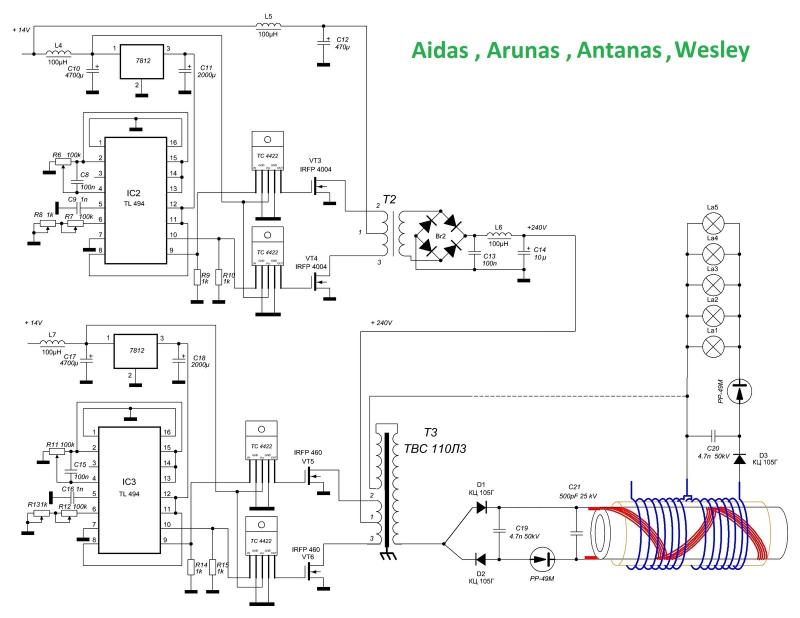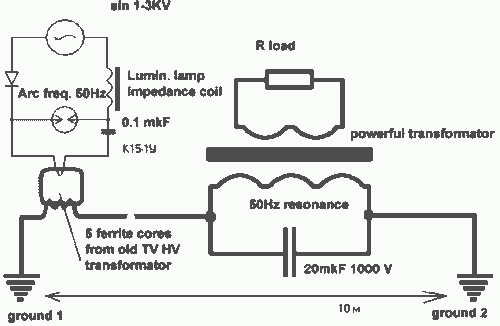
Kapanadze 5
Warning: Undefined array key "extension" in /var/www/html/nextgr/view-circuit.php on line 468
Deprecated: strtolower(): Passing null to parameter #1 ($string) of type string is deprecated in /var/www/html/nextgr/view-circuit.php on line 468
The emitter voltage drops completely to 0V from 42V during the pulse when the transistor is conducting or saturated. This contrasts with a pure resistive load (the 4.7 Ohm resistor mentioned in the previous video), where the collector-emitter voltage does not drop to 0V from 12V during the pulse, indicating that the transistor is not fully conducting or saturated. The difference lies in the pure resistive load (4.7 Ohm) operating at a low 12V, compared to the combination of a toroid (with a flyback) and a 1 Ohm resistor at a 42V collector voltage. The collector-emitter voltage drops completely to 0V from 42V during the pulse when the transistor is conducting or saturated. Modifying the nano-pulser to use a 100K Ohm potentiometer instead of the current 10K Ohm may allow for an increase in pulse width, thereby fully saturating the transistor at a higher collector voltage. The probe tip and ground are reversed, with the probe tip connected at the junction of the capacitor and filter, and the ground at the junction of the flyback diode and capacitor. The slope of the green line represents the unsaturated inductance, while the slope of the yellow line represents the saturated inductance. The blue dot on the current trace indicates the saturation point. The green line's slope should evaluate to 173 H (for the 6-turn inductance), and the yellow line's slope should evaluate to 30nH, assuming the 6-turn winding is wound in air, which has a relative permeability of 1. Shorting the winding/inductor temporarily should result in a rectangular current pulse, provided the BJT switches quickly enough. The presence of a colored ferrite usually indicates an iron powdered core, which typically has low permeability. A high permeability of 4700 could explain the core's saturation at low voltage in this circuit. The inconsistency in color coding for inductor toroid materials across manufacturers can be frustrating, as each has its own code. Additionally, ferrite and powdered iron are distinct materials, and various kinds of ferrite are used in inductors. Proprietary part numbers from manufacturers like HP or Tektronix for common semiconductors can also be a source of frustration.
In this circuit analysis, the behavior of the transistor under different load conditions is examined. The emitter voltage's complete drop to 0V during saturation indicates effective transistor operation, allowing for maximum current flow. The comparison with the resistive load highlights the importance of load characteristics in determining the transistor's operational state. The use of a 100K Ohm potentiometer indicates an intent to adjust the circuit for optimal performance, as increasing the resistance may allow for longer pulse widths, which is critical for ensuring full saturation of the transistor at higher voltages.
The distinction between the slopes of the inductance traces is significant, as it provides insight into the inductor's behavior under varying current conditions. The evaluation of inductance in both saturated and unsaturated states is crucial for understanding the inductor's performance in the circuit. The saturation point, marked by the blue dot, serves as an essential reference for evaluating the magnetic characteristics of the inductor.
Furthermore, the discussion on the challenges of identifying toroid materials and their properties underscores the complexity of working with inductors in electronic design. The variability in manufacturer color codes can lead to confusion and misinterpretation of component specifications. This highlights the need for careful consideration and verification of inductor characteristics, particularly in applications requiring precise performance parameters. The mention of proprietary part numbers emphasizes the importance of sourcing components from reliable suppliers and understanding their specifications to ensure compatibility and functionality in circuit designs.Emitter voltage completely drops to 0V from 42V during the pulse (transistor conducting or transistor saturated). That in contrary with the pure resistive load (the 4. 7 Ohm resistor in the last video), where the Collector - Emitter voltage NOT completely drops to 0V from 12 V during the pulse (transistor not fully conducting or not fully saturated) The difference is the pure
resistive load (4. 7 Ohm) only with low 12V and the combination of toroid (+ flyback) with 1 Ohm resistor with 42V collector voltage. LOL, probably, what i mean is that the Collector - Emitter voltage completely drops to 0V from 42V during the pulse (transistor conducting or transistor saturated).
So if i again modify my nano-pulser and use the 100KOhm pot (instead of the 10K now) perhaps i can increase the pulse width even more to fully saturate the transistor at even higher collector voltage. Almost; the probe tip /ground is reversed, so the probe tip is at the junction csr / filter cap, and the ground on the junction flyback diode / csr, see at 13:59 in the video.
The slope of the green line represents your unsaturated inductance and the slope of the yellow line represents your saturated inductance. The blue dot placed at the knee of the current trace represents what is known as the "saturation point".
The slope of the green line should evaluate to 173 H (your 6-turn inductance) and the slope of the yellow line should evaluate to 30nH (as if the 6t winding was wound over the air, which has r = 1 ). You can disprove this terrifying hypothesis by temporarily shorting out the winding/inductor. When you do this, the current pulse should become rectangular, if the BJT is switching quickly enough.
I only query this as a coloured ferrite typically indicates an iron powdered core and these have fairly low permeability. Also 4700 seems very high. However, a very high permeability of 4700 would explain why itsu`s core is saturating in this circuit at low voltage.
One of the most frustrating things in electronics has got to be the lack of a consistent, industry-wide color coding for inductor toroid materials. Almost every manufacturer has its own color code, so if you are presented with a random toroid, say. pea-green. and you don`t know the manufacturer. you might as well be colorblind. And of course "ferrite" and "powdered iron" are two different things, and there are many different kinds of ferrite materials used in inductors.
But you knew that already. The other most frustrating thing is when manufacturers like HP or Tektronix use their own proprietary part numbers for common semiconductors. Drives me nuts. 🔗 External reference
In this circuit analysis, the behavior of the transistor under different load conditions is examined. The emitter voltage's complete drop to 0V during saturation indicates effective transistor operation, allowing for maximum current flow. The comparison with the resistive load highlights the importance of load characteristics in determining the transistor's operational state. The use of a 100K Ohm potentiometer indicates an intent to adjust the circuit for optimal performance, as increasing the resistance may allow for longer pulse widths, which is critical for ensuring full saturation of the transistor at higher voltages.
The distinction between the slopes of the inductance traces is significant, as it provides insight into the inductor's behavior under varying current conditions. The evaluation of inductance in both saturated and unsaturated states is crucial for understanding the inductor's performance in the circuit. The saturation point, marked by the blue dot, serves as an essential reference for evaluating the magnetic characteristics of the inductor.
Furthermore, the discussion on the challenges of identifying toroid materials and their properties underscores the complexity of working with inductors in electronic design. The variability in manufacturer color codes can lead to confusion and misinterpretation of component specifications. This highlights the need for careful consideration and verification of inductor characteristics, particularly in applications requiring precise performance parameters. The mention of proprietary part numbers emphasizes the importance of sourcing components from reliable suppliers and understanding their specifications to ensure compatibility and functionality in circuit designs.Emitter voltage completely drops to 0V from 42V during the pulse (transistor conducting or transistor saturated). That in contrary with the pure resistive load (the 4. 7 Ohm resistor in the last video), where the Collector - Emitter voltage NOT completely drops to 0V from 12 V during the pulse (transistor not fully conducting or not fully saturated) The difference is the pure
resistive load (4. 7 Ohm) only with low 12V and the combination of toroid (+ flyback) with 1 Ohm resistor with 42V collector voltage. LOL, probably, what i mean is that the Collector - Emitter voltage completely drops to 0V from 42V during the pulse (transistor conducting or transistor saturated).
So if i again modify my nano-pulser and use the 100KOhm pot (instead of the 10K now) perhaps i can increase the pulse width even more to fully saturate the transistor at even higher collector voltage. Almost; the probe tip /ground is reversed, so the probe tip is at the junction csr / filter cap, and the ground on the junction flyback diode / csr, see at 13:59 in the video.
The slope of the green line represents your unsaturated inductance and the slope of the yellow line represents your saturated inductance. The blue dot placed at the knee of the current trace represents what is known as the "saturation point".
The slope of the green line should evaluate to 173 H (your 6-turn inductance) and the slope of the yellow line should evaluate to 30nH (as if the 6t winding was wound over the air, which has r = 1 ). You can disprove this terrifying hypothesis by temporarily shorting out the winding/inductor. When you do this, the current pulse should become rectangular, if the BJT is switching quickly enough.
I only query this as a coloured ferrite typically indicates an iron powdered core and these have fairly low permeability. Also 4700 seems very high. However, a very high permeability of 4700 would explain why itsu`s core is saturating in this circuit at low voltage.
One of the most frustrating things in electronics has got to be the lack of a consistent, industry-wide color coding for inductor toroid materials. Almost every manufacturer has its own color code, so if you are presented with a random toroid, say. pea-green. and you don`t know the manufacturer. you might as well be colorblind. And of course "ferrite" and "powdered iron" are two different things, and there are many different kinds of ferrite materials used in inductors.
But you knew that already. The other most frustrating thing is when manufacturers like HP or Tektronix use their own proprietary part numbers for common semiconductors. Drives me nuts. 🔗 External reference


